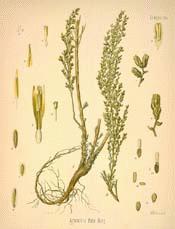
Botanical.com Home Page

|
Santonica
(Artemisia cina BERG.)
Click on graphic for larger image
|
Wormseed, Levant
Botanical: Artemisia cina (BERG.)
Family: N.O. Compositae
---Synonyms---Sea Wormwood. Santonica. Semen Sanctum. Semen Cinae. Semen Contra. Semen Santonici. Artemesia Lercheana. Artemisia maritima, var. Stechmanniana. Artemisia maritima, var. pauciflora. Artemesia Chamaemelifolia.
(Italian) Semenzina.
---Part Used---Seeds.
The Levant Wormseed, largely imported into Britain, is derived from a variety of the Sea Wormwood. Several species of Wormwood are mentioned by Dioscorides as being effective as a vermifuge, one of which was reported as growing in the country of the Santones in Gaul. Its ancient reputation has been maintained in modern times, for the universally employed vermifuge Santonin (the very name derived from classic days) is produced from Santonica - popularly called Wormseed - which consists of the minute, dried, unexpanded flower-heads of a Russian variety of the Sea Wormwood (Artemisia maritima, var. Stechmanniana, Bess.). This variety, which some botanists consider to be a distinct species, under the name of A. Cina (Berg.), or A. chamaemelifolia (Vill.), grows in profusion in Siberia, Turkestan and Chinese Mongolia. The greater part of the Wormseed is used in Turkestan, where it grows in enormous quantities in the desert of the Kirghiz, especially near the town of Chimkent, where a factory has been erected in which large quantities of Santonin are produced from the Wormseed collected in the vicinity, not more than 10 per cent of the drug being now exported in the crude state, in which condition it is known in this country as Levant Wormseed. The plant is low and shrubby, throwing up a number of erect stems on which the little greenish-yellow, oblong flower-heads are borne. Each head is about 1/8 inch long and 1/16 inch in diameter, and contains three to five minute, tubular flowers. In July and August, before the flowers expand, they are stripped from the stems and dried, being brought into Chimkent by the Kirghiz and other tribes.
Wormseed has long been used as an anthelmintic. Tragus, in 1531, in Brunfels' Herbal, mentions Wormseed as being imported by way of Genoa; it was employed in Italy under the name of Semenzina (diminutive of Semenza, seed), in the belief that it consisted of small seeds. From this word is derived the name of Semen cinae, by which the drug is often known: Semen contra (another of its names) is an abbreviation of Semen contra vermes. The drug at first sight appears to consist of a number of small brownish, ridged seeds, and it is not till they are closely examined that their true nature becomes apparent.
The drug exhales when crushed an agreeable aromatic odour, and possesses a bitter, aromatic camphoraceous taste. As imported, it frequently contains considerable fragments of the leaves and slender flower-stalks.
[Top]
---Constituents---The chief constituent of Wormseed is a crystalline principle, Santonin, to which the anthelmintic property of the drug is due. Santonin attains its maximum 2.3 to 3.6 per cent in July and August; after the flowerheads have expanded, it rapidly diminishes in quantity. It is extracted from the flower-heads by treating them with Milk of Lime, the Santonin being converted into soluble calcium santonate. It occurs in colourless, shining, flat prisms, without odour and almost tasteless at first, but afterwards developing a bitter taste. It is sparingly soluble in water, but soluble in alcohol and ether.
Wormseed also contains a crystalline substance, Artemisin, and a yellow volatile oil consisting of Cineol, to which its odour is due.
---Medicinal Action and Uses---Wormseed is one of the oldest and most common anthelmintics, especially for children. In domestic practice the seeds are used powdered, combined with honey or treacle, the dose of the seeds taken thus in substance being 10 to 30 grains. The seeds have also been employed in infusion or decoction, but in these forms their bitterness is a strong objection. As a general rule, however, the crude drug Wormseed is seldom administered, its active constituent Santonin being employed. It acts as a direct poison to parasites, and is used as a remedy for round-worms, which it rapidly expels; it has also an effect on thread-worms to a lesser degree, but has no action on tapeworms. It is usually administered as a powder or in lozenges, not in solution, and is often given with calomel, or compound powder of scammony.
---Preparations---Santonin, 2 to 5 grains. Santonin lozenges, B.P.
Several cases are on record of fatal poisoning by Santonin, and Santonin rendered yellow by exposure to direct sunlight is sometimes preferred, it being stated to be less poisonous. It is known as yellow Santonin, or Photosantonin.
Even small doses of Santonin will produce remarkable effects on the vision, appreciation of colour being so disturbed that objects appear to have a yellowish tinge, which is sometimes preceded by a faint colour. Santonin may also cause headache, nausea and vomiting, and in large doses, epileptiform convulsions.
See:
MUGWORT
WORMWOOD
[Top]
Common Name Index
A MODERN HERBAL Home Page
Bear in mind "A Modern Herbal" was written with the conventional wisdom of the early 1900's. This should be taken into account as some of the information may now be considered inaccurate, or not in accordance with modern medicine.
© Copyright Protected 1995-2024 Botanical.com
|

